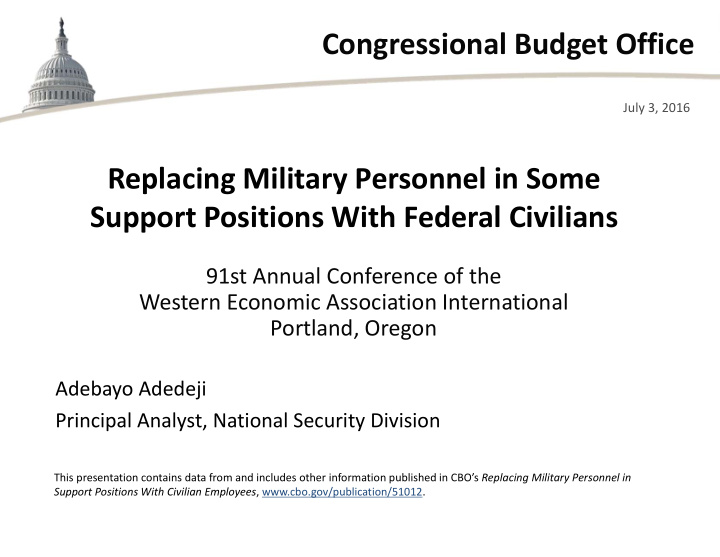



Congressional Budget Office July 3, 2016 Replacing Military Personnel in Some Support Positions With Federal Civilians 91st Annual Conference of the Western Economic Association International Portland, Oregon Adebayo Adedeji Principal Analyst, National Security Division This presentation contains data from and includes other information published in CBO’s Replacing Military Personnel in Support Positions With Civilian Employees , www.cbo.gov/publication/51012.
The Potential to Expand the Role of the Department of Defense’s (DoD’s) Civilian Employees 1 CONGRESSIONAL BUDGET OFFICE
Transferring to civilians certain jobs currently held by military personnel could reduce costs and increase DoD’s focus on warfighting. Doing so would not lead DoD into uncharted waters because it has previous experience with such transfers. 2 CONGRESSIONAL BUDGET OFFICE
For this analysis, CBO used DoD’s Inherently Governmental and Commercial Activities (IGCA) database for 2012 to identify the number and types of positions that it might make sense to transfer. 3 CONGRESSIONAL BUDGET OFFICE
CBO also estimated possible cost savings for DoD and the federal government if DoD reduced military end strength by the number of such positions transferred. 4 CONGRESSIONAL BUDGET OFFICE
Military Positions in the Services and Defensewide Organizations, by Function, 2012 Percent 100 75 Inherently Governmental Commercial 50 but Not Open to Contractors 25 Commercial and Open to Contractors 0 Army Navy Air Force Marine Corps Defensewide Organizations 5 CONGRESSIONAL BUDGET OFFICE
Two main job categories exist in the IGCA database: • Inherently governmental jobs, which only government employees (military or civilian) can perform; those account for 62 percent of all jobs in the database. • Commercial jobs that use skills or provide services available in the private sector; those account for 38 percent of all jobs in the database. 6 CONGRESSIONAL BUDGET OFFICE
Military and Civilian Positions in the DoD, by Function, 2012 7 CONGRESSIONAL BUDGET OFFICE
For many reasons, the services place military personnel in commercial jobs, which they implement in different ways. Those reasons include: • Meeting readiness objectives • Achieving workforce management goals • Complying with laws, executive orders, treaties, or international agreements 8 CONGRESSIONAL BUDGET OFFICE
Military Positions in Commercial Functions Not Open to Contractors, by Reason, 2012 Thousands 300 250 200 150 Needed for Required by Law, Workforce Executive Order, Management 100 Treaty, or Objectives International Agreement Needed for 50 Readiness 0 Army Navy Air Force Marine Corps 9 CONGRESSIONAL BUDGET OFFICE
Estimating the Number of Positions That Could be Transferred to Civilians 10 CONGRESSIONAL BUDGET OFFICE
Accepting the existing classification of positions as inherently governmental or commercial, CBO’s analysis instead addresses how to achieve less a costly blend of military personnel and civilians. 11 CONGRESSIONAL BUDGET OFFICE
To answer that question, the analysis focuses on occupations in nondeployable units in which the services use different mixes of military personnel and civilians. 12 CONGRESSIONAL BUDGET OFFICE
CBO estimates that, if all services use the same mix of the service branch with the smallest percentage of military personnel, about 80,000 active ‐ duty positions could be available for transfer. 13 CONGRESSIONAL BUDGET OFFICE
CBO considered three options for transferring 80,000 positions to civilian employees: • One civilian replaces one service member (1:1 ratio) • Four civilians replace every five service members (1:1.25 ratio) • Two civilians replace every three service members (1:1.5 ratio) 14 CONGRESSIONAL BUDGET OFFICE
Scenarios for Civilians Replacing 80,000 Military Personnel Thousands of Positions Existing Replacement Ratio (Civilian:Military) Commercial Positions Service Transferable to Civilians 1:1 1:1.25 1:1.5 Army 14.0 14.0 11.2 9.3 Navy 36.0 36.0 28.8 24.0 Air Force 24.0 24.0 19.2 16.0 Marine Corps 6.0 6.0 4.8 4.0 Total 80.0 80.0 64.0 53.3 15 CONGRESSIONAL BUDGET OFFICE
Estimating the Cost Savings From Transferring the Positions to Civilians 16 CONGRESSIONAL BUDGET OFFICE
The cost analysis compares all current and future costs of hiring a service member to those of hiring a civilian. Because some of those costs are borne by agencies other than DoD, CBO calculates the cost to the federal government, including revenue effects. 17 CONGRESSIONAL BUDGET OFFICE
The ratio at which civilians replace military personnel is a key factor determining total cost savings. 18 CONGRESSIONAL BUDGET OFFICE
Average Annualized Cost, by Department, of Employing a Service Member and a Federal Civilian in Comparable Occupations 2014 Dollars Military–Civilian Department and Cost Category Military Civilian Difference Department of Defense 103,400 106,100 ‐ 2,700 Department of Veterans Affairs 34,000 n.a. 34,000 Department of the Treasury 5,000 n.a. 5,000 Office of Personnel Management n.a. 4,000 ‐ 4,000 Department of Education 300 300 * Total Federal Government Spending 142,700 110,100 32,600 Tax Revenues From Basic Pay and Special, Incentive, and Other Pay ‐ 7,500 ‐ 14,100 6,600 Net Cost to the Federal Government 135,200 96,000 39,200 n.a. = not applicable; * = less than $100. 19 CONGRESSIONAL BUDGET OFFICE
Estimated Long ‐ Run Annualized Savings From Transferring 80,000 Military Support Positions to Civilians 20 CONGRESSIONAL BUDGET OFFICE
Other Considerations 21 CONGRESSIONAL BUDGET OFFICE
Civilians have advantages beyond lower costs, such as greater stability or familiarity with technological advances for which military personnel would require additional training. However, there are disadvantages to shedding military positions. 22 CONGRESSIONAL BUDGET OFFICE
Achieving the cost savings depends on cutting military end strength—an action that would reduce DoD’s ability to surge troops in a protracted conflict. Also, reducing commercial positions could have adverse effects on the services’ workforce management goals or unique needs. 23 CONGRESSIONAL BUDGET OFFICE
Recommend
More recommend